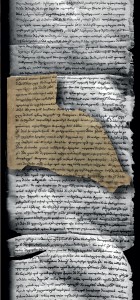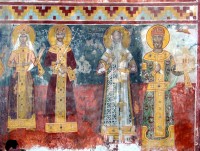 The Simon Janashia Museum of Georgia in Tbilisi, Georgia, has put on display the only surviving fragment of the last will and testament of the 12th century King of Georgia, David the Builder. The Georgia’s Medieval Treasury exhibition “showcases Georgian Christian art that reflected the unity and continuity of cultural traditions and formed the basis of the Georgian statehood and the national identity.” It opened in June but the objects on display are constantly changing and the will only went on display a week ago. It is the first time this priceless relic has been on public display.
The Simon Janashia Museum of Georgia in Tbilisi, Georgia, has put on display the only surviving fragment of the last will and testament of the 12th century King of Georgia, David the Builder. The Georgia’s Medieval Treasury exhibition “showcases Georgian Christian art that reflected the unity and continuity of cultural traditions and formed the basis of the Georgian statehood and the national identity.” It opened in June but the objects on display are constantly changing and the will only went on display a week ago. It is the first time this priceless relic has been on public display.
David the Builder is Georgia’s greatest national hero. Just 16 years old when his father abdicated in his favor, David fought the Seljuk Turks for more than 20 years, chipping off territories under their control from 1101 until 1123 when he wrested their last stronghold of Dmanisi from them and unified the country. According to Arabic scholars like Badr al-Din al-Ayni, David the Builder respected other faiths, granted legal protection to Muslims and Jews living in the kingdom as well as adherents to minority Christian denominations like the Armenian Apostolic Church.
 In 1125, King David wrote a will and determined the orderly succession of his kingdom. He died on January 24th of that year. He was just 53 years old but had reigned for 36 years. His son Demetrius succeeded him. The Georgian Orthodox Church canonized him a saint for his dedication to the faith.
In 1125, King David wrote a will and determined the orderly succession of his kingdom. He died on January 24th of that year. He was just 53 years old but had reigned for 36 years. His son Demetrius succeeded him. The Georgian Orthodox Church canonized him a saint for his dedication to the faith.
Together the reigns of David the Builder and his granddaughter Tamar (r. 1184–1213) are considered the Georgian Golden Age, a military, political and cultural Renaissance in the east hundreds of years before Western Europe got around to it. The Golden Age didn’t long outlive Queen Tamar. First the Mongol invasions of the 1230s and 40s broke Georgian independence, rendering it a vassal state. In the late 14th century Timur (Tamerlane) devastated the country and forced the king to pay tribute. By 1466, the Kingdom of Georgia no longer existed even in name only; it disintegrated into several small kingdoms and principalities. It was carved up some more by neighboring powers — Persia and the Ottoman Empire, then the Russian Empire which absorbed it in 1801.
Even after centuries without a functional Georgian state, Georgian cultural identity still held on strong and David the Builder was widely revered. On display along with the fragment of the will is a glass negative of the whole document made in 1895 by photographer and Georgian nationalist Alexander Roinashvili. He took numerous photographic portraits of prominent Georgian public figures and of important sites and objects of Georgian cultural heritage. So dedicated was he to sharing and promoting Georgian history that he conceived the idea of a mobile museum of Georgian antiquities that would feature both photographs and historical artifacts — weapons, silverware, coins — he’d collected for years. In 1887, Roinashvili finally got his museum off the ground and took it on tour. The museum never did travel as far and wide as Roinashvili had hoped, but it’s thanks to his unwavering committment to documenting Georgian culture that we have a copy of David the Builder’s will.
Very new data for me. Timur I had heard of and I knew that there was a Georgia in Central Europe, but I had learned little more.
Imagine being only one person to collect and preserve your nation’s entire history. What a feat! It doesn’t sound like he had much assistance in preserving the history and would in fact be in danger doing so with Georgia being a former State of th U.S.S.R. They didn’t seem fond of nationalism in any form.
Do you know if there are any plans to put more of the museum’s collections online? I for one would like to know more.
Multias Gratias ago tibi, Livius Drusus!
Vale!
Salve C.A. ! … As early as 337AD, Georgia itself was among the first to adopt Christianity. However, its location is not exactly Central Europe.
Moreover, in case they ‘didn’t seem fond of nationalism’, it might be explained by their Soviet dictator, who himself came from Georgia:
A certain Iosseb Bessarionis dse Dschughaschwili, or (russ.) Иосиф Виссарионович Джугашвили, (georg.) იოსებ ბესარიონის ძე ჯუღაშვილი, and otherwise known as ‘Stalin’.
:hattip:
So what happened to the document after it was photographed complete in 1895, leaving only the fragment wwe have today?
The will seems to be written in nusxa-xucuri, an angular script that was used between the ninth and eleventh centuries, but with a few variants hinting at mxedruli, the rounded Georgian letters used today. From a strictly calligraphic standpoint, this has to be one of the prettiest documents I’ve ever seen. It’s Tolkienesque.
This is what I’m curious about, although I suspect two world wars and generations of Soviet rule are responsible.
So Uncle Joe was Georgian? Didn’t know that. I at least know that there are places like Uzbekistan, Georgia, Kazakhstan, and Turkmenistan. So I get half points. I know they’re there and were part of the U.S.S.R. So I can’t really find them on the map. Sigh. I didn’t get geography in school. Imagine my confusion when I found out where Dacia was! It took the National Geographic to show me. I’m embarrassed to say. Where I come from I was exceedingly lucky to get Latin. If I learned anything about Emperors or the Empire I was blindingly educated. Most people I know can only name two Emperors, Julius Caesar and Caesar Augustus and that only because of the Bible or Sweet Will. If you tell them that Rome was a republic they stare at you.
Ah, Education! Alas how much I lack!
Thank you for giving me more to chew on and understand! I appreciate it more than I can say. And I agree, the script is beautiful. It does remind me of Anglo-Saxon but it is it’s own gorgeous self.